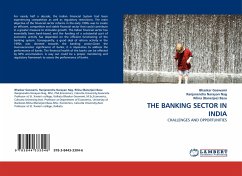
THE BANKING SECTOR IN INDIA
CHALLENGES AND OPPORTUNITIES
Versandkostenfrei!
Versandfertig in 6-10 Tagen
32,99 €
inkl. MwSt.

PAYBACK Punkte
16 °P sammeln!
For nearly half a decade, the Indian Financial System had been experiencing competition as well as regulatory restrictions. The main objective of the financial sector reforms in the early 1990s was to create an efficient, competitive and stable financial sector that could contribute in a greater measure to stimulate growth. The Indian financial sector has essentially been bank-based, and the funding of a substantial part of economic activity has depended on the efficient functioning of the banking system. Consequently, a good deal of reform activity in the 1990s was directed towards the bankin...
For nearly half a decade, the Indian Financial System had been experiencing competition as well as regulatory restrictions. The main objective of the financial sector reforms in the early 1990s was to create an efficient, competitive and stable financial sector that could contribute in a greater measure to stimulate growth. The Indian financial sector has essentially been bank-based, and the funding of a substantial part of economic activity has depended on the efficient functioning of the banking system. Consequently, a good deal of reform activity in the 1990s was directed towards the banking sector.Given the macroeconomic significance of banks, it is imperative to address the performance of banks. The financial health of the banks can be affected by NPA accumulation. A way out could be a proper monitoring and regulatory framework to assess the performance of banks.












